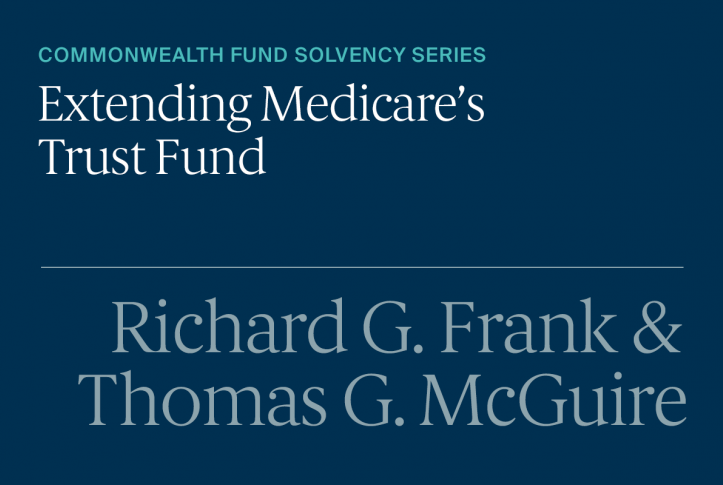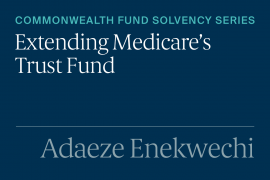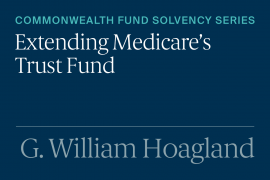The Medicare Hospital Insurance (HI) Trust Fund, which pays for Medicare beneficiaries’ hospital bills and other services, is projected to become insolvent in 2031. Without changes to expected spending or trust fund revenue, the trust fund will not have sufficient funds to cover the entire cost of beneficiaries’ health care. The HI trust fund is primarily funded through payroll taxes paid by employers and employees, with some additional income from interest as well as premiums paid by voluntary enrollees not automatically entitled to Medicare Part A. Will the trust fund solvency be extended by reducing the projected growth in expenditures, raising revenues, changes to the services covered by Medicare Part A, or a combination of these options
To stimulate policy discussions, the Commonwealth Fund asked a group of Medicare thought leaders with a variety of backgrounds and political affiliations to outline how they would extend the life of the trust fund. This series presents their perspectives, highlighting areas of commonality while also putting forth some new ideas for addressing this pressing issue.
Revenue Changes
Sources of personal income have shifted substantially since the creation of Medicare. In the late 1960s, wages and salaries accounted for about 66 percent of personal income. This share has fallen to roughly 50 percent, meaning that the payroll tax funding for Medicare Part A is levied on a smaller share of total income. The payroll tax is regressive, omitting income sources more prevalent among wealthier households, such as income from investments. Furthermore, the amount of taxable payroll is reduced by deductions of employers’ health insurance contributions, which disproportionately benefits higher-income households.
To address these imbalances, we propose two policies. The first would reform the net investment income tax (NIIT) established by the Affordable Care Act and referred to as the unearned income Medicare contribution. We propose including income from S-corporations (so-called pass throughs) and limited partnerships in the tax base. We also propose increasing the tax rate to 4 percent from 3.8 percent. For a household earning $300,000 of which $50,000 was unearned, that would imply a tax increase of $100 if the investment income is currently covered by NIIT. These funds would be directed to the trust fund. Based on CBO and Tax Policy Center analyses, we estimate new revenues of more than $490 billion over 10 years.
The second policy would limit employers’ ability to deduct health insurance contributions from the payroll tax. This would make purchasing decisions for health insurance more efficient by reducing the tax subsidy to health insurance and make the payroll tax more equitable. It has been estimated that payroll tax deductibility costs $106 billion per year. Reducing the employer health insurance deductibility by half amounts to increased revenues equal to roughly one-fourth of the total costs of deductibility, because the employer pays only 50 percent of the payroll tax. This amounts to approximately $26 billion per year in new revenues to the trust fund.
Medicare Advantage
The health plans that participate in the Medicare Advantage (MA) program have experienced strong enrollment growth and relatively large price-to-cost margins. The Medicare Payment Advisory Commission (MedPAC) reports that some features of existing payment arrangements likely result in overpayment to MA health plans.
Enhance the Coding Intensity Adjustment
Medicare pays MA plans more for beneficiaries who have higher medical risk scores, determined in part by the diagnoses recorded in health claims by the plans. Paying on recorded diagnoses creates an incentive for plans to increase coding intensity to increase their revenues. Medicare reduces payments to plans to account for some increased coding intensity; this is referred to as a “coding intensity adjustment.” MedPAC estimated coding intensity in MA to be 8 percent higher than in traditional Medicare in 2018. Another estimate found it was 11 percent higher in 2017. In 2019, the CBO estimated that increasing the coding adjustment to reduce overpayment by at least 8 percent would yield $47 billion in savings over 10 years, of which $21 billion (44%) would be attributed to the trust fund.
Adjust Medicare Advantage Payments to Account for Reduced Utilization Stemming from COVID-19
In the second quarter of 2020, insurers with large MA enrollment reported declines in utilization of 30 percent in March and April. By June there was some recovery, but subsequent reports indicate that utilization remained 10 percent below historical levels in July, reducing trust fund spending in traditional Medicare for Part A by an estimated $8.4 billion. For MA plans, the reduced utilization constituted an unexpected windfall. We propose clawing back some of these profits using ex poste limits on MA plan profits.
Change the Framing of Medicare Advantage Premium Prices to Beneficiaries
Reframing the way MA premiums are presented could help beneficiaries understand the potential savings of joining MA and encourage more to opt for cost-effective plans. Many MA plans are currently referred to as “zero-premium” plans, which means that beneficiaries pay no premium above Part B ($148.50 for 2021). That is, the MA plan premium above the overall Medicare Part B premium (if any; known as the “supplemental premium”) is added to the Part B premium. We propose presenting beneficiaries the true full premiums for all plans, including traditional Medicare, online and in marketing material. Instead of seeing zero supplemental premium for an MA plan, the beneficiary would see $148.50 for traditional Medicare and a monthly premium of approximately $135.00 for an efficient MA plan. This increase in transparency will help beneficiaries make better choices and reward MA plans for reducing the full premium below the mandatory Part B amount. If such reframing would reduce bids of the zero-premium plans by an average of 5 percent, then 2.2 percent, or about $6.25 billion per year and $62 billion over 10 years, would accrue to the trust fund.
Base Medicare Advantage Benchmarks on Competitive Bidding
Currently MA plans bid to provide services for beneficiaries against a benchmark, which is based on the local level of spending in traditional Medicare. Decoupling MA bids from the local spending–defined benchmark has been proposed previously. Defining benchmarks based on local MA plan bids rather than local costs in traditional Medicare would do a better job at pushing bids toward the costs of a standardized benefit package. In some markets, MA plans account for a very high share of total enrollment, making cost patterns in traditional Medicare not a reasonable estimate of costs for the average Medicare beneficiary, particularly if there is systematic risk selection between traditional Medicare and MA plans. Competitive bidding proposals would set a benchmark level for payment based on the second-lowest bidder, an approach that has been found by CBO to create 10-year savings of about $44 billion.
Conclusions
Without major changes, the Medicare HI Trust Fund will soon be insolvent. We have proposed a package of revenue and policy changes that would improve the financial status of the trust fund by roughly $800 billion over 10 years, amounting to 12 years of additional life for the Fund.







